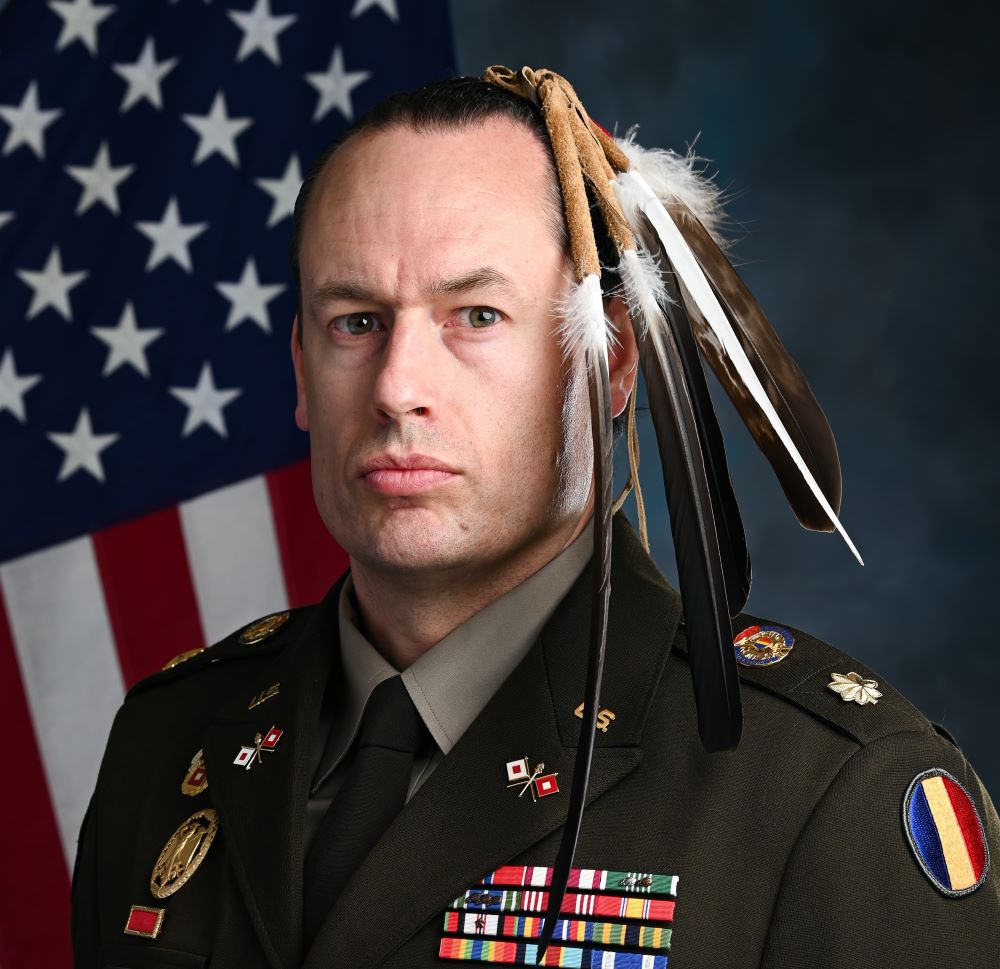A year ago, U.S. Army Major Patrick Sorensen ('06, Chemistry) gained national attention when his portrait went viral. In the photo, his hair is long, and he’s wearing ceremonial Native American feathers while in uniform, varying from the standard dress code for male soldiers.
He was motivated to request a religious accommodation to the men's dress code after attending an American Indian Science and Engineering Society conference. There, Sorensen met Air Force women from the Indigenous Nations Equality Team, who discussed religious accommodations for Native Americans in the Air Force. This inspired Sorensen, who wanted to grow his hair longer than regulation but thought it wasn't possible, to seek similar accommodations.
Sorensen is a member of the Confederated Tribes of Grand Ronde, a federally recognized tribe. He was taught that hair represents spirit and strength and that eagle feathers are used to send his prayers to the Creator above as it flies highest in the sky. The eagle feather is a nearly universal religious symbol across all Indigenous Tribes in North America and can represent many religious beliefs. Sorensen wears his feathers in military uniform to represent his fallen soldiers.
Now, as one of very few Native American U.S. Army service members who've been given the exemption, he is helping others gain religious accommodations to do the same. He has helped about 70 other Native American service members across different branches of the U.S. military request their own accommodations to wear their regalia and honor their heritage and religion while in uniform.
“When I requested the accommodation, I wanted to include the length of my hair and the eagle feathers. I understood that I wasn't just doing this for myself but for other Native service members who wish to do the same. I'm focused on helping the next generation and younger soldiers who are seeking accommodations. I want them to reach their full potential and excel in life. It's also important to note that the religious practice of wearing feathers and regalia is not limited to men; it applies to women as well,” Sorensen says.
Growing up, he moved around frequently because his mother was a registered nurse. Though his father, who is Native American, was raised on the reservation in Grand Ronde, Oregon, Sorensen was not enrolled in his Tribe as a child. He was proud of his Native American heritage but did not fully understand the complexities of Tribal enrollment. It wasn’t until 2009 that he enrolled in the Confederated Tribes of Grand Ronde.
Sorensen spent most of his childhood in and around Humboldt County, primarily in a remote cabin in Dinsmore, California. One day, he discovered a chemistry textbook and decided to read it, sparking his passion for the subject. He humorously refers to himself as a certified nerd for finding joy in reading a chemistry textbook.
With the support of Trio Upward Bound, a federally funded college preparatory program for low-income high school students—Sorensen attended Cal Poly Humboldt to study chemistry.
He especially enjoyed his labs. Several faculty members in the Chemistry department had a positive impact on Sorensen, including Professors William Golden, Robert Zoellner, and Kjirsten Wayman.
One particular lesson from Golden has resonated deeply with Sorensen and continues to influence him. Golden emphasized the limitations of scientific understanding; equations and scientific concepts, he explained, are merely attempts to interpret the world, and do not yield true understanding.
“He emphasized that there is a great deal of mystery in the world, and it’s essential to keep an open mind,” Sorensen says. “This idea resonated with me, especially in the sciences—particularly chemistry—where we often strive to categorize everything neatly. Professor Golden pointed out that this approach doesn’t reflect reality. The truth is that the world is filled with mystery and confusion, and our goal is to create order to navigate through this fascinating world.”
Sorensen's open-mindedness, inspired by Golden’s insights, goes hand in hand with recognizing how important it was for him to honor his cultural and spiritual identity, challenging strict norms, especially in a military system that is typically neat and uniform.
Sorensen’s time at Cal Poly Humboldt was one of significant growth. As a first-generation student at a four-year university, Sorensen navigated living independently and making lifelong friendships.
After graduating from Cal Poly Humboldt, Sorensen enlisted in the U.S. Army as a way to pay off his student loans and gain laboratory experience. Since then, he has held many positions within the Army including as a biological research assistant, senior communications manager, assistant operations officer, and marketing officer. He is now a Marketing and Public Affairs Operations Officer for the U.S. Army Training and Doctrine Command, where he manages marketing and public relations operations.
Sorensen says he’s received nothing but support from the Army. He says the Army is dedicated to fostering a supportive environment that encourages soldiers to reach their full potential, including accommodating their individual religious beliefs.
“They genuinely wanted me to be at my physical, mental, and spiritual best so that I could be the best soldier possible. There are many leaders like me throughout the force who are eager to support the next generation of soldiers and service members as they join. We are here to help them succeed, regardless of whether that means continuing on their current career path or exploring new opportunities. That’s our mission,” Sorensen says.

